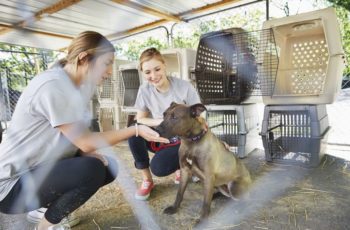
Dogs drool. Some just drool a little once in a while, while others (we’re looking at you, Newfoundlands) drool a lot. Drooling can happen for structural, behavioral, and medical reasons.
Normal Drooling
Dogs commonly drool in the presence of food or when they really want something. Male dogs, especially intact males, will drool in the presence of a female dog or when sniffing where a cute girl urinated. These are normal instances of drooling, and while kind of gross, the cause is easy to identify and it is nothing to worry about.
Some dogs are also just plain built to drool. Dogs with loose, floppy jowls tend to be heavy droolers because their saliva pools in the lips and then drips out. Bloodhounds, Coonhounds, Mastiffs, Basset Hounds, and Dogues de Bordeaux are a few breeds that come with a spit warning. If your dog is naturally drooly, keep clean hand towels on hand to wipe his lips and chin, especially after drinking.
Why is My Dog Drooling So Much All of a Sudden?
If your dog is not typically a drooler, or if he starts drooling more than usual, there may be something amiss.
Stress Drool
One cause of excessive drooling is stress. You may notice your dog drooling around other dogs that he doesn’t know, during veterinary visits, or during thunderstorms. Stress-related drooling will usually be accompanied by other signs of stress and anxiety, such as shaking, tense posture, wide eyes, and whining.
Dental Pain
Dogs frequently drool when their mouths hurt. If your dog is drooling and acting strange, such as pawing at his mouth or rubbing his face on the ground, carefully check his mouth for an object that is stuck between the teeth or an injury such as a cut or wasp sting. Dogs who like to chew on sticks frequently get a piece stuck cross-wise on the roof of the mouth, so be sure to check there.
How to Remove Something Stuck in the Mouth
If your dog has something stuck in his mouth, you can try to remove it yourself, but be careful.
- Calm your dog with long, slow pets and by talking in a calm voice.
- Lift the lips to check the other parts of the mouth, including the teeth and the space between the lips and gums. Go all the way around the mouth, top and bottom.
- Gently open your dog’s mouth by grasping his upper and lower jaw behind the big canine teeth. Check the roof of his mouth and the back of the throat if you are able.
- If you see a stuck object, use your entire hand to gently try to remove it. It is harder for your dog to accidentally bite down if your entire fist is in his mouth versus just two fingers.
- If the object does not come free easily, leave it! Forcefully removing something stuck could severely damage your dog’s mouth.
If you are not able to easily remove the foreign object, call your dog’s veterinarian. They will be able to sedate your dog to safely remove the item when she is relaxed.
Drooling due to dental disease often comes on gradually and gets worse over time. As plaque and calculus build up on your dog’s teeth and the gums become irritated, his body produces saliva to try to soothe the inflamed tissues and flush out invaders. If your dog fractures a tooth, you may notice a sudden increase in drooling.
Other signs of dental disease include:
- Red or bleeding gums
- Calculus buildup on the teeth
- Gum recession (teeth look longer)
- Difficulty or reluctance to chew
- Bad breath
Nausea
Dogs often drool when they feel nauseous. Nausea can be caused by many different things, ranging from a simple upset stomach to more serious illnesses such as pancreatitis, parvovirus, or kidney failure. Dogs can also get motion sickness just like humans.
If your dog is drooling due to nausea, he will likely be a bit lethargic and withdrawn, and not eating well. Some dogs approach their food bowls like they want to eat, but then turn away, drooling. He may vomit, but this is not always the case.
Toxicity
Drooling is a symptom of toxicity for a number of plants, toads, frogs, food items, and chemicals that are toxic to dogs. Exact symptoms will vary depending on what toxic item your dog was exposed to and how much.
If you know or suspect that your dog has gotten into something poisonous, call one of these hotlines:
Pet Poison Helpline (855) 764-7661
ASPCA Animal Poison Control Center (888) 426-4435
Bloat
Gastric dilatation and volvulus, commonly known as bloat, is most common in large, deep-chested dogs, but can affect any of our canine companions. Symptoms include:
- Drooling
- Retching or dry heaving without successfully throwing anything up
- Pacing
- Restlessness
- Panting
- Tense abdomen
- Distended abdomen
Bloat is an emergency and requires immediate veterinary intervention.
Seizures
Dogs often drool in the post-ictal period after having a seizure. Seizures generally only last a minute or two, but your dog may be out of sorts for a lot longer. Other behaviors that dogs may display after a seizure include disorientation, wobbliness, temporary vision impairment, and agitation or aggression.
If your dog has a seizure, seek veterinary care to determine why the seizure occurred and start treatment if needed. If a seizure lasts more than five minutes, this is an emergency.
When is Drooling an Emergency?
Drooling itself is not an emergency. However, if your dog is drooling and acting strange, the excessive drool may be a symptom of a more serious problem.
Drooling requires a vet visit if it is accompanied by:
- Vomiting
- Poor appetite
- Bad breath and signs of dental disease
- Frequent stress and anxiety
- Weight loss
- Lethargy
Drooling is an emergency and requires immediate veterinary care if it is accompanied by:
- Signs of bloat such as a distended abdomen and nonproductive retching
- An item stuck in the mouth or throat
- Vomiting and diarrhea
- Neurological signs such as staggering, circling, or falling over
- Seizures
- Known or suspected exposure to a toxin
- Difficulty breathing
- Unconsciousness
If your dog seems fine overall but is drooling more than usual without an obvious explanation, a vet visit never hurts. Excessive drooling without other symptoms of illness or injury is not an emergency, but a full physical exam and some routine bloodwork are a good idea to check for early signs of a problem.


